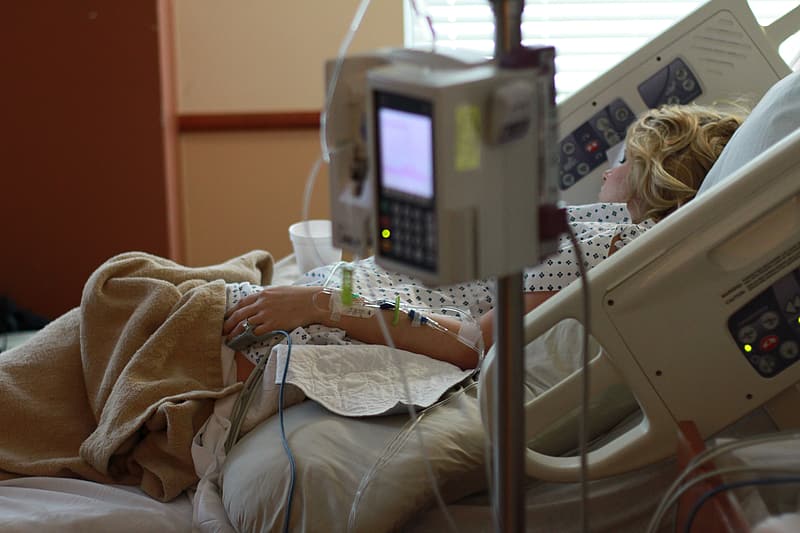As we scramble to locate hospital beds and life-saving equipment during this pandemic, remember that we are fighting two diseases.
By Les Leopold
If you or your loved ones become seriously ill during this pandemic crisis, either with Covid-19 or for any other reason, there may not be a hospital bed or life-saving equipment available for you. How can that be given that we spend twice as much on health care than any other country on Earth?
Maybe that’s just the way things go when a massive unexpected healthcare problem strikes. Yes, surely the government could have been better prepared by stockpiling more personal protective equipment and ventilators, given the pandemic guidance they received 15 years ago. But is it really possible for hospitals to have enough beds and costly equipment in times of crisis?
The fact is that between 1980 and today, 400,000 hospital beds have vanished from our system while Wall Street financed a bonanza of hospital mergers and acquisitions. Given population growth of 100 million over this period, this means that the number of hospital beds per 100,000 people in the US has fallen by more than half. In 1980 there was 595 hospital bed for every 100,000 people. Today there’s only 281 per 100,000.
Certainly some of those beds were removed because of changes in medical care. New surgical techniques have emerged that require shorter hospital stays. There also are more outpatient options today, and Medicare has changed its hospital reimbursement policies that have impacted the number of hospital beds. But entire hospitals have disappeared. In 1980 there were 3 hospitals per 100,000 people in the U.S. — in 2019, only 1.9. (For sources see here and here.)
But aren’t mergers supposed to improve care through technological efficiencies and the sharing of medical know-how? Unfortunately, that’s not the case. A recent study published in the New England Journal of Medicine (January 2, 2020) found that “Hospital acquisition by another hospital or hospital system was associated with modestly worse patient experiences and no significant changes in readmission or mortality rates.“ Too bad for us.
Hospitals have not gotten better because that is not the point of all these Wall Street-driven mergers. The real and ever-present goal is to extract as much wealth as possible from the hospital system to enrich big investors and CEOs. The extraction takes the form of ever-rising executive compensation and ubiquitous stock buybacks. Hospitals are increasingly designed to make the rich richer, not to provide high-quality health care to the rest of us.
The top seven hospital chains have amassed nearly a trillion dollars in sales over the past decade with more than $35 billion in net profits. Where does all that profit come from? From merging hospitals and cutting “excess” bed capacity and staffing to the bone.
| Largest Hospital For-Profit Corporations | Sales ($billions) | Profits ($billions) | Stock Buybacks 2010-19 ($billions) | CEO Compensation |
| HCA HEALTHCARE INC | $387 | $23.2 | $13.5 | $20,100,000 |
| COMMUNITY HEALTH SYSTEMS INC | $152 | -$4.5 | $0.4 | $7,024,719 |
| TENET HEALTHCARE CORP | $149 | $0.2 | $0.9 | $15,000,000 |
| DAVITA INC | $108 | $6.1 | $6.9 | $32,000,000 |
| UNIVERSAL HEALTH SVCS INC | $87 | $5.9 | $2.3 | $23,588,883 |
| SELECT MEDICAL HOLDINGS CORP | $37 | $1.3 | $0.4 | $8,201,031 |
| ENCOMPASS HEALTH CORP | $30 | $3.0 | $0.5 | $6,388,227 |
| TOTALS, SEVEN HOSPITAL CHAINS | $951 | $35.2 | $24.9 | $112,302,860 |
Stock Buybacks
In addition to high CEO salaries, private hospital corporations use stock buybacks to enrich themselves at the expense of hospital staffing, beds, and equipment. By using the company’s funds to buy shares in the open market, the price of those shares rises thereby enriching Wall Street investors and the CEOs who receive most of their compensation in stock options and grants. Just these seven companies squeezed nearly $25 billion from the hospitals over the past decade to pay for those stock buybacks.
A Wall Street Grab for Hospital Real Estate
In addition to stock buybacks, there is wealth to be extracted from the real estate under hospitals. Here’s one current example in Philadelphia:
- Wall Street investor Joel Freedman bought Hahnemann Hospital in Philadelphia, a safety-net hospital with 400 beds and an E.R. that saw 40,000 patients a year. Two-thirds of patients admitted were Black or Latinx.
- Freedman “had scant experience in day-to-day hospital management and displayed little patience with the executives he brought in to run the two hospitals.” He made no major capital investments to improve the hospital.
- Less than 18 months after buying it, Freedman declared bankruptcy and shut down the hospital.
Valuable Real Estate Kept Out of Bankruptcy
- Usually with a bankruptcy, all assets—land, buildings, equipment, etc.—are sold to meet financial obligations.
- Hahnemann Hospital sat on valuable real estate in a gentrifying area of the city and Freedman managed to keep the land out of the bankruptcy—leaving him free to sell the land to the highest bidder.
Many believe that Freedman never seriously tried to save the hospital. According to the WHYY story, Eileen Applebaum, of the Center for Economic and Policy Research, said “she is worried that a separate sale of the Hahnemann property to a developer will lay a road map for private equity firms around the country: Buy older hospitals in areas that are gentrifying, separate the hospital from its real estate, let the hospitals go downhill, and then sell the real estate to the developers.”
So as we scramble to locate hospital beds and life-saving equipment during this pandemic, remember that we are fighting two diseases. The first is the pandemic that feasts on our bodies. The second is Wall Street that feasts on our health care system. Lean and mean may be good for profits but not for Grandma.

